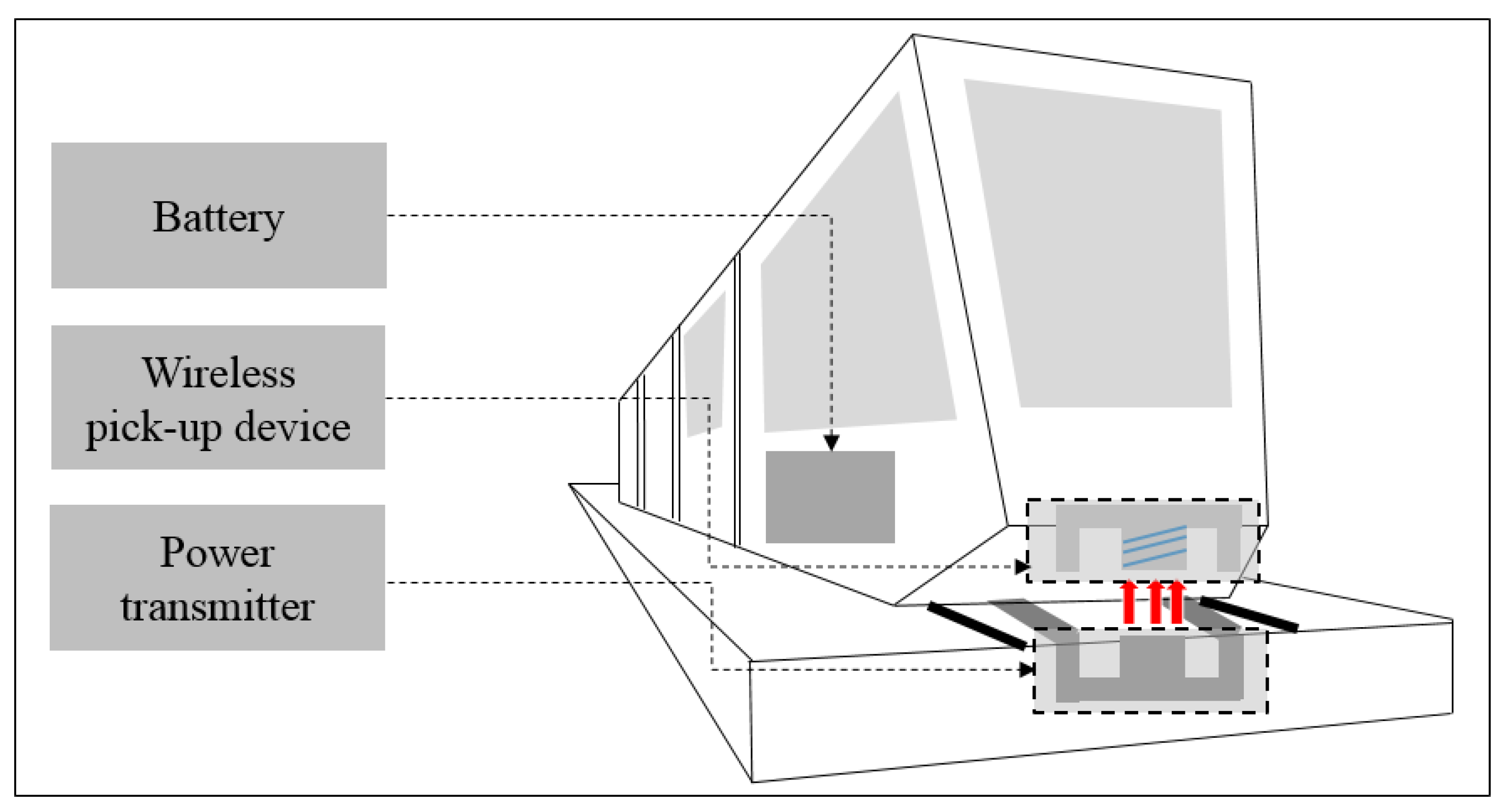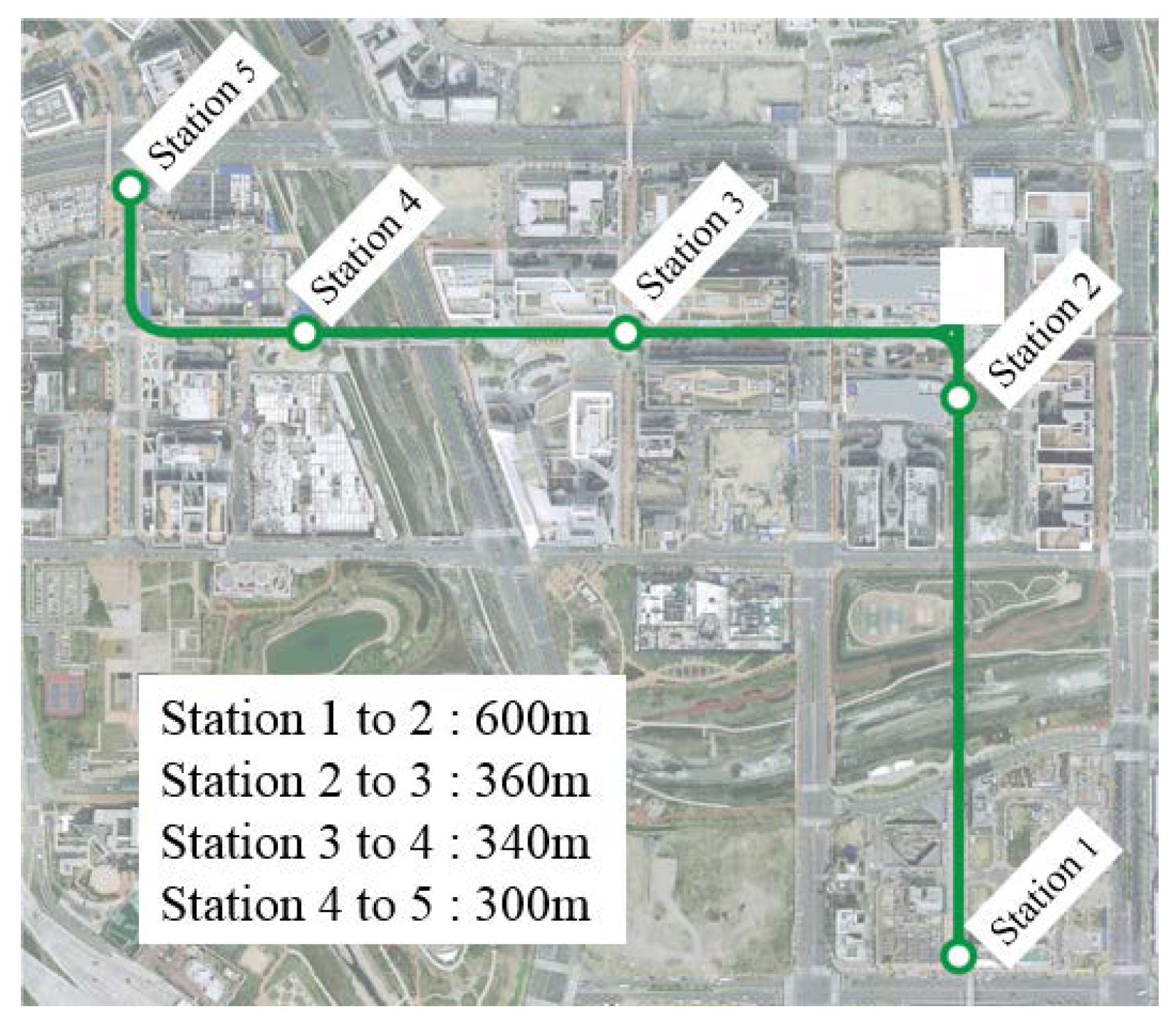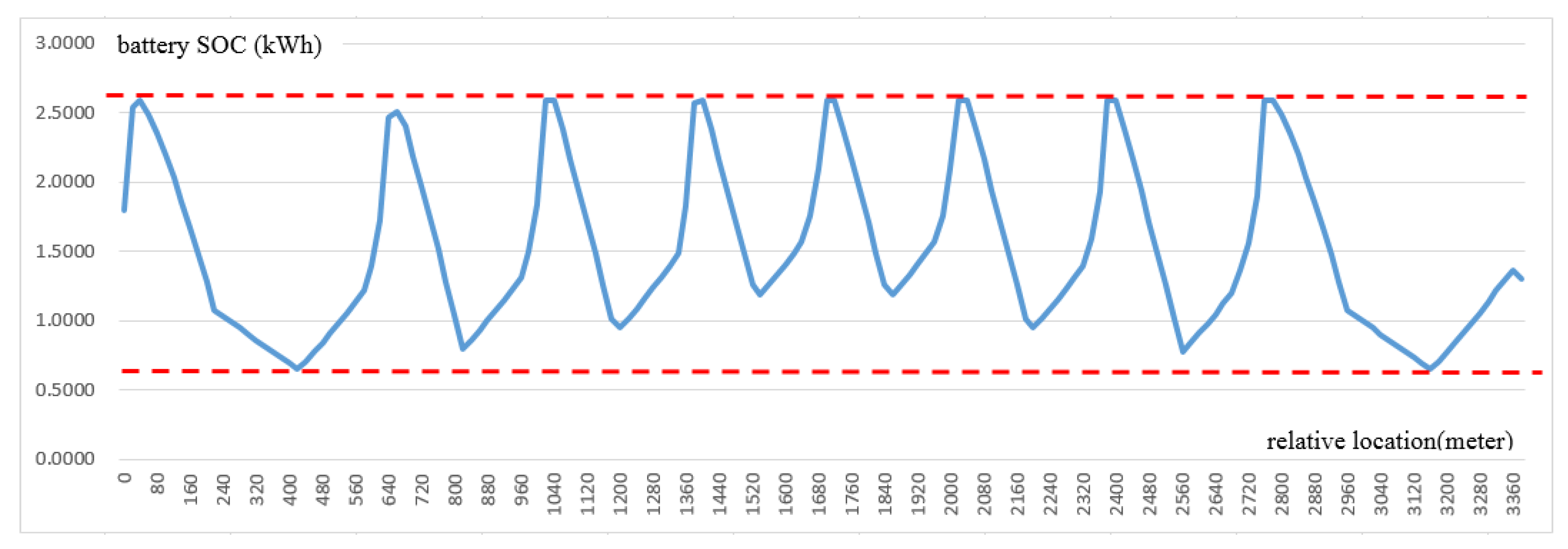Efficient Deployment Design of Wireless Charging Electric Tram System with Battery Management Policy
Abstract
1. Introduction
2. Literature Review
3. Problem Description
3.1. Problem Statement
3.2. Overall Procedure
3.2.1. Data Collection
3.2.2. Battery Consumption Calculation
3.2.3. Optimal System Design
3.2.4. Real Application
4. Mathematical Model
4.1. Notation
| Index | ||
| i | : | Set of segments; overall route is divided by I number of segments (i = 1,2, 3…, I) |
| Decision variables | ||
| Icapa | : | Maximum capacity of battery installed in wireless charging electric tram [kWh] |
| Itarget | : | Target battery charging level before operation at first station [kWh] |
| kinverter(i) | : | 0–1 binary decision variable; if the inverter is allocated in ith segment, then value of 1, otherwise, value of 0 |
| kcable(i) | : | 0–1 binary decision variable; if the inductive cable is allocated in ith segment, then value of 1, otherwise, value of 0 |
| Variables | ||
| ninverter | : | Total number of inverters applied in overall system [unit] |
| ncable | : | Total length of inductive cable applied in overall system [meter] |
| Imax | : | Upper limit of battery utilization area regarding maximum battery capacity [kWh] |
| Imin | : | Lower limit of battery utilization area regarding maximum battery capacity [kWh] |
| I (0) | : | Initial battery charging level before operation at first station [kWh] |
| I(i) | Battery charging level after passing ith segment [kWh] | |
| Input parameters | ||
| ntram | : | Total number of wireless charging electric trams in overall system [unit] |
| cbattery | : | Battery cost per unit kWh [$/kWh] |
| cinverter | : | Unit inverter cost [$/unit] |
| ccable | : | Inductive cable cost per unit length [$/meter] |
| αmax | : | Ratio of upper limit of battery utilization area regarding maximum battery capacity |
| αmin | : | Ratio of lower limit of battery utilization area regarding maximum battery capacity |
| kcable(0) | : | Initial value for allocation of inductive cable, which is set as 0 |
| s(i) | : | Electricity supply by wireless charging in ith segment [kWh] |
| r(i) | : | Electricity supply by regenerative braking in ith segment [kWh] |
| l(i) | : | Length of ith segment [meter] |
4.2. Model Formulation
5. Numerical Example
5.1. System Parameters
5.2. Computational Result
6. Concluding Remarks
Author Contributions
Funding
Conflicts of Interest
References
- Costa, A.; Fernandes, R. Urban public transport in Europe: Technology diffusion and market organisation. Transp. Res. Part A Policy Pract. 2012, 46, 269–284. [Google Scholar]
- Cho, D.; Jung, G.; Yoon, U.; Lee, B. Development & implementation of electric tram system with wireless charging technology. ICT Express 2015, 1, 34–38. [Google Scholar]
- Ko, Y.D.; Jang, Y.J. The optimal system design of the online electric vehicle utilizing wireless power transmission technology. IEEE Trans. Intell. Transp. Syst. 2013, 14, 1255–1265. [Google Scholar] [CrossRef]
- Shinohara, N. Power without wires. IEEE Microw. Mag. 2011, 12, S64–S73. [Google Scholar] [CrossRef]
- Lu, X.; Wang, P.; Niyato, D.; Kim, D.I.; Han, Z. Wireless charging technologies: Fundamentals, standards, and network applications. IEEE Commun. Surv. Tutor. 2016, 18, 1413–1452. [Google Scholar] [CrossRef]
- Waffenschmidt, E.; Staring, T. Limitation of inductive power transfer for consumer applications. In Proceeding of the 13th European Conference on Power Electronics and Applications, Barcelona, Spain, 8–10 September 2009; pp. 1–10. [Google Scholar]
- Cannon, B.L.; Hoburg, J.F.; Stancil, D.D.; Goldstein, S.C. Magnetic resonant coupling as a potential means for wireless power transfer to multiple small receivers. IEEE Trans. Power Electron. 2009, 24, 1819–1825. [Google Scholar] [CrossRef]
- Kline, M.; Izyumin, I.; Boser, B.; Sanders, S. Capacitive power transfer for contactless charging. In Proceedings of the 2011 Twenty-Sixth Annual IEEE Applied Power Electronics Conference and Exposition (APEC), Fort Worth, TX, USA, 6–11 March 2011; pp. 1398–1404. [Google Scholar]
- Jabbar, H.; Song, Y.S.; Jeong, T.T. RF energy harvesting system and circuits for charging of mobile devices. IEEE Trans. Power Electron. 2010, 56, 247–253. [Google Scholar] [CrossRef]
- Machura, P.; Li, Q. A critical review on wireless charging for electric vehicles. Renew. Sust. Energy Rev. 2019, 104, 209–234. [Google Scholar] [CrossRef]
- Shi, B.; Yang, F.; Wang, S.; Ouyang, M. Efficiency Improvement of Wireless Charging System Based on Active Power Source in Receiver. IEEE Access 2019, 7, 98136–98143. [Google Scholar] [CrossRef]
- Bi, Z.; Keoleian, G.A.; Lin, Z.; Moore, M.R.; Chen, K.; Song, L.; Zhao, Z. Life cycle assessment and tempo-spatial optimization of deploying dynamic wireless charging technology for electric cars. Transp. Res. Part C Emerg. Technol. 2019, 100, 53–67. [Google Scholar] [CrossRef]
- He, J.; Yang, H.; Tang, T.Q.; Huang, H.J. Optimal deployment of wireless charging lanes considering their adverse effect on road capacity. Transp. Res. Part C Emerg. Technol. 2020, 111, 171–184. [Google Scholar] [CrossRef]
- Huh, J.; Lee, S.; Park, C.; Cho, G.H.; Rim, C.T. High performance inductive power transfer system with narrow rail width for on-line electric vehicles. In Proceedings of the 2010 IEEE Energy Conversion Congress and Exposition (ECCE), Atlanta, GA, USA, 12–16 September 2010; pp. 647–651. [Google Scholar]
- Wang, C.S.; Stielau, O.H.; Covic, G.A. Design considerations for a contactless electric vehicle battery charger. IEEE Trans. Ind. Electron. 2005, 52, 1308–1314. [Google Scholar] [CrossRef]
- Huang, C.Y.; Boys, J.T.; Covic, G.A.; Budhia, M. Practical considerations for designing IPT system for EV battery charging. In Proceedings of the 2009 IEEE Vehicle Power and Propulsion Conference, Dearborn, MI, USA, 7–10 September 2009; pp. 402–407. [Google Scholar]
- Fujii, N.; Mizuma, T. Analytical study of special linear motor-transformer for wireless tram. In Proceedings of the 2008 IEEE Industry Applications Society Annual Meeting, Edmonton, AB, Canada, 5–9 October 2008; pp. 1–7. [Google Scholar]
- Lee, S.B.; Ahn, S.; Lee, J.H.; Jang, I.G. Optimization of the wireless power transfer system in an electric railway. In Proceedings of the 2014 IEEE Wireless Power Transfer Conference (WPTC), Jeju, Korea, 8–9 May 2014; pp. 158–161. [Google Scholar]
- Miyamoto, H.; Morimoto, M.; Morita, K. On-line SOC estimation of battery for wireless tram car. In Proceedings of the 7th International Conference on Power Electronics and Drive Systems, Bangkok, Thailand, 27–30 November 2007; pp. 83–89. [Google Scholar]
- Miyamoto, H.; Morimoto, M.; Morita, K. Online SOC estimation of battery for wireless tramcar. Electr. Eng. Jpn. 2014, 186, 83–89. [Google Scholar] [CrossRef]
- Li, J.Q. Battery-electric transit bus developments and operations: A review. Int. J. Sustain. Transp. 2016, 10, 157–169. [Google Scholar] [CrossRef]
- Giménez-Gaydou, D.A.; Ribeiro, A.S.; Gutiérrez, J.; Antunes, A.P. Optimal location of battery electric vehicle charging stations in urban areas: A new approach. Int J. Sustain. Transp. 2014, 10, 393–405. [Google Scholar] [CrossRef]
- Ko, Y.D.; Jang, Y.J.; Lee, M.S. The optimal economic design of the wireless powered intelligent transportation system using genetic algorithm considering nonlinear cost function. Comput. Ind. Eng. 2015, 89, 67–79. [Google Scholar] [CrossRef]
- Oh, Y.K.; Kwak, J.H.; Lee, H.Y. The SOC Management Strategy of Battery System for Propulsion in Wireless Low Floor System. In Proceedings of the KSR Conference; Korean Society for Railway: Jeju, Korea, 2011; pp. 2329–2335. [Google Scholar]
- Plötz, P.; Funke, S.Á.; Jochem, P. The impact of daily and annual driving on fuel economy and CO2 emissions of plug-in hybrid electric vehicles. Transp. Res. Part A Policy Pract. 2018, 118, 331–340. [Google Scholar] [CrossRef]
- Jong, J.C.; Chang, E.F. Models for estimating energy consumption of electric trains. J. East Asia Soc. Transp. Stud. 2005, 6, 278–291. [Google Scholar]






| Notation | Meaning | Value |
|---|---|---|
| Ntram | Number of wireless charging electric tram [unit] | 5 |
| cbattery | Battery cost per unit kWh [$/kWh] | $50,000 |
| cinverter | Unit inverter cost [$/unit] | $5000 |
| ccable | Inductive cable cost per unit length [$/meter] | $200 |
| αmax | Ratio of upper limit of battery utilization area | 0.8 |
| αmin | Ratio of lower limit of battery utilization area | 0.2 |
| l(i) | Length of ith segment [meter] | 20 |
| Content | Value |
|---|---|
| Total investment cost | $1,125,725 |
| The optimal battery capacity | 3.2389 kWh |
| Target battery charging level before operation at first station | 1.7997 kWh |
| Total number of inverters | 8 units |
| Total length of inductive cable | 1380 m |
| Location of 1st inductive cable | 0 m–420 m |
| Location of 2nd inductive cable | 580 m–680 m |
| Location of 3rd inductive cable | 960 m–1040 m |
| Location of 4th inductive cable | 1340 m–1400 m |
| Location of 5th inductive cable | 1640 m–1720 m |
| Location of 6th inductive cable | 1960 m–2040 m |
| Location of 7th inductive cable | 2320 m–2400 m |
| Location of 8th inductive cable | 2680 m–3160 m |
© 2020 by the authors. Licensee MDPI, Basel, Switzerland. This article is an open access article distributed under the terms and conditions of the Creative Commons Attribution (CC BY) license (http://creativecommons.org/licenses/by/4.0/).
Share and Cite
Ko, Y.D.; Oh, Y. Efficient Deployment Design of Wireless Charging Electric Tram System with Battery Management Policy. Sustainability 2020, 12, 2920. https://doi.org/10.3390/su12072920
Ko YD, Oh Y. Efficient Deployment Design of Wireless Charging Electric Tram System with Battery Management Policy. Sustainability. 2020; 12(7):2920. https://doi.org/10.3390/su12072920
Chicago/Turabian StyleKo, Young Dae, and Yonghui Oh. 2020. "Efficient Deployment Design of Wireless Charging Electric Tram System with Battery Management Policy" Sustainability 12, no. 7: 2920. https://doi.org/10.3390/su12072920
APA StyleKo, Y. D., & Oh, Y. (2020). Efficient Deployment Design of Wireless Charging Electric Tram System with Battery Management Policy. Sustainability, 12(7), 2920. https://doi.org/10.3390/su12072920





